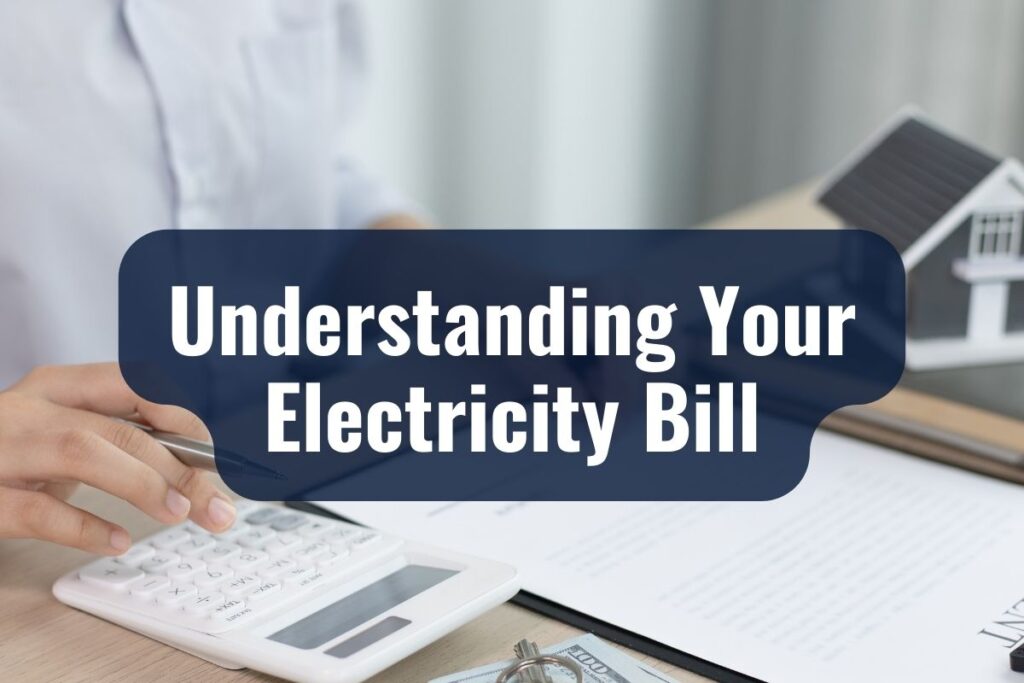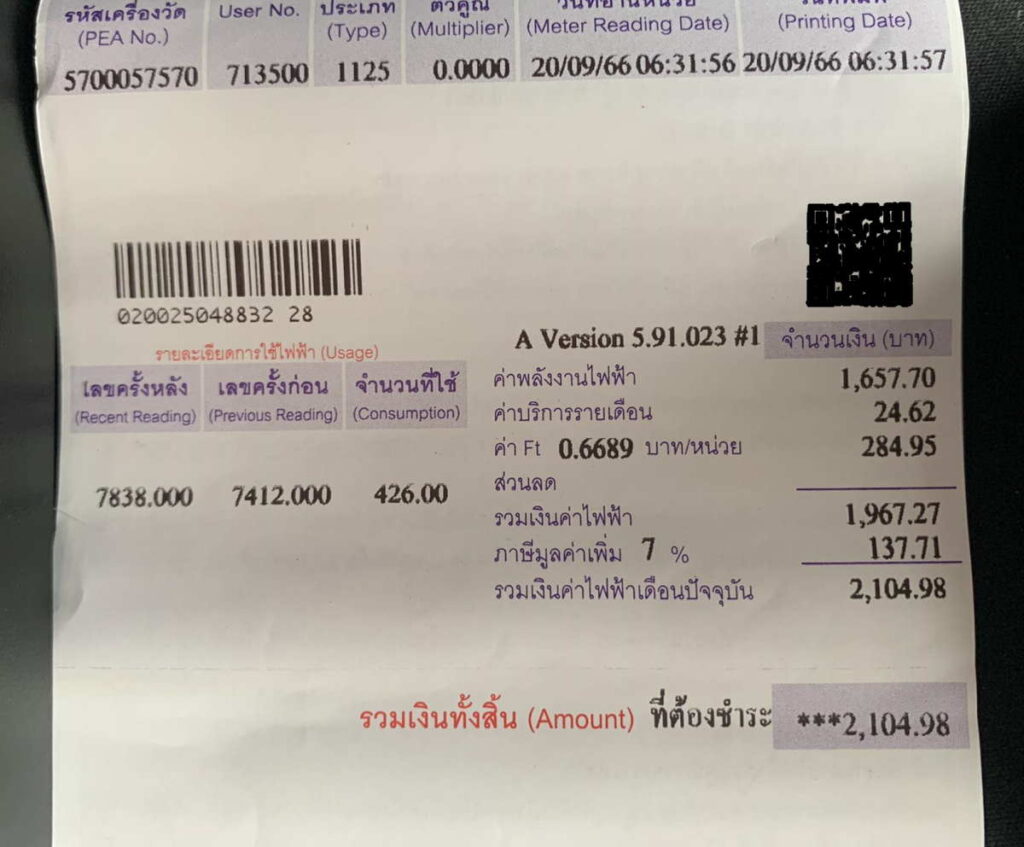In Thailand, where the tropical climate demands consistent use of electrical appliances like fans and air conditioners, being aware of electricity prices becomes even more essential.
This article delves into the intricacies of electricity prices in Thailand, offering clarity on how they are determined and what influences the cost. Whether you’re setting up a new home or just curious about your monthly bills, this guide aims to shed light on the subject, ensuring you’re well-informed and prepared.
KEY TAKEAWAYS
- Thailand’s electricity landscape has evolved significantly from its early days, reflecting the nation’s growth and modernization.
- The current electricity pricing structure in Thailand is a blend of base charges, tiered usage rates, and additional fees.
- Major electricity providers in Thailand include EGAT, PEA, MEA, and some private entities, each catering to different regions and needs.
- Adopting energy-efficient practices and appliances can significantly reduce electricity consumption.
- Alternative energy sources like solar and wind are gaining traction in Thailand, offering sustainable options for residents.
Historical Context
Thailand’s journey with electricity is a tale of rapid development and modernization. From its humble beginnings to its current state, understanding this history provides valuable insights into present-day electricity pricing and infrastructure.
The Early Days
In the early 20th century, electricity in Thailand was a luxury, limited to the royal palaces and a few affluent neighborhoods in Bangkok. It was only in the 1930s that the government began to recognize the potential of electricity as a tool for national development. This led to the establishment of the first state-owned electricity department.
Birth of EGAT
The 1960s marked a significant turning point for electricity in Thailand with the formation of the Electricity Generating Authority of Thailand (EGAT). As the primary power producer and grid operator, EGAT played a pivotal role in expanding the electricity network across the country. Their efforts ensured that both urban and rural areas had access to reliable power, transforming the nation’s landscape.
Evolution of Prices
Over the decades, electricity prices in Thailand have been influenced by a myriad of factors. The global energy crises of the 1970s, for instance, saw a spike in prices due to the heavy reliance on imported oil. However, as Thailand diversified its energy sources, incorporating natural gas, hydroelectric power, and later, renewable energy, the prices stabilized.
The government’s policies, aimed at promoting industrial growth and improving the quality of life for its citizens, also played a role in shaping the electricity tariffs. Subsidies were introduced for certain sectors, and efforts were made to keep prices affordable for the general populace.
Modern Challenges and Developments
The turn of the century brought new challenges and opportunities. With the rise of technology and increased urbanization, the demand for electricity surged. Thailand, recognizing the need for sustainable growth, began investing in renewable energy sources and exploring innovative solutions to meet the growing demand without compromising on environmental concerns.
Current Pricing Structure

Navigating the electricity pricing structure in Thailand can initially seem complex, especially for those new to the country. However, with a clear breakdown of its components, one can better understand how costs are determined and what to expect on their monthly bills.
Base Charge and Unit Pricing
At the heart of the pricing structure is the base charge, a fixed amount that every consumer pays regardless of their consumption. This charge covers the basic operational costs of the electricity provider.
Beyond this, consumers are billed based on their actual electricity usage, measured in kilowatt-hours (kWh). The unit price per kWh can vary based on several factors, including the type of consumer (residential, commercial, or industrial) and the total monthly consumption.
Tiered Pricing System
Thailand employs a tiered pricing system for residential consumers. This means that the cost per kWh increases as one’s monthly consumption goes up. The idea behind this system is to encourage energy conservation. For instance:
- The first slab might charge a lower rate for the initial set of kWh consumed.
- As consumption exceeds this initial slab, the rate per kWh increases for the subsequent slabs.
This progressive system ensures that those who consume less electricity benefit from lower rates, while heavy consumers pay a premium.
Peak and Off-Peak Rates
Another factor influencing the electricity cost is the time of consumption. Thailand, like many countries, has peak and off-peak hours. Using electricity during peak hours, typically during the daytime when demand is highest, might be more expensive than during off-peak times, usually late night to early morning. This differential pricing aims to balance the load on the electricity grid.
Additional Charges and Taxes
Apart from the base charge and usage-based charges, there might be additional fees on the bill. These can include service fees, taxes, or other levies imposed by the government or the electricity authority. It’s essential to be aware of these additional charges to get a comprehensive understanding of the total bill.
Comparison of Electricity Providers
Thailand’s electricity landscape is dominated by a few key players, each with its own set of tariffs, service offerings, and operational regions.
| Provider | Operational Scope | Pros | Cons |
| EGAT | National power producer and grid operator | Extensive coverage; Consistent service | Less personalized customer service; Standardized rates |
| PEA | Distribution in provincial areas | Understands provincial needs; Quick local response | Varying infrastructure; Rates can differ by region |
| MEA | Distribution in Bangkok, Nonthaburi, and Samut Prakan | Advanced infrastructure; Streamlined customer service | Potential for unexpected outages; Slightly higher rates |
| Private Providers | Specific regions or industries | Tailored solutions; Personalized service | Limited operational regions; Varying rates |
For foreigners and locals alike, understanding the differences between these providers can be crucial in making informed decisions about which one best suits their needs.
Electricity Generating Authority of Thailand (EGAT)
EGAT is the national power producer and grid operator. While it primarily focuses on generating electricity, it also plays a role in transmission across the country.
Pros
- Extensive coverage, ensuring most regions have access to electricity.
- Consistent service and reliability due to its dominant position in the market.
Cons
- Being a large entity, customer service might not always be as personalized.
- Rates are standardized, offering little room for negotiation or tailored packages.
Provincial Electricity Authority (PEA)
PEA is responsible for distributing electricity in the provincial areas outside of Bangkok, Nonthaburi, and Samut Prakan.
Pros
- Has a deep understanding of the specific needs and challenges of provincial regions.
- Often quicker to respond to local outages or issues due to its regional focus.
Cons
- Might not have the same level of infrastructure development as metropolitan areas.
- Rates can vary based on the region and the challenges associated with supplying electricity to that area.
Metropolitan Electricity Authority (MEA)
MEA manages the distribution of electricity within Bangkok, Nonthaburi, and Samut Prakan.
Pros
- Given its focus on metropolitan areas, it often boasts advanced infrastructure and technology.
- Customer service is often more streamlined, with multiple channels of communication.
Cons
- High demand in metropolitan areas can sometimes lead to unexpected outages.
- Rates might be slightly higher due to the complexities of managing a dense urban grid.
Private Providers
In addition to the major state-run entities, there are also private electricity providers in Thailand. These often cater to specific regions or industries.
Pros
- Can offer tailored solutions and packages based on individual or business needs.
- Might provide more personalized customer service.
Cons
- Limited operational regions might mean they’re not an option for everyone.
- Rates can vary significantly based on the provider and the services they offer.
Understanding Your Electricity Bill

For many, especially those new to Thailand, the monthly electricity bill can initially appear as a maze of numbers and unfamiliar terms. However, with a bit of guidance, deciphering the bill becomes a straightforward task. Here’s a breakdown of the typical components you’ll find on your electricity bill in Thailand.
Basic Information

At the top of the bill, you’ll find basic details such as:
- Account Number: A unique identifier for your electricity account.
- Billing Period: The specific dates for which you’re being charged.
- Address: The location where the electricity is being supplied.
Consumption Details
This section provides a snapshot of your electricity usage:
Previous Reading: The meter reading from the end of the last billing cycle.
Current Reading: The meter reading at the end of this billing cycle.
Total Consumption: The difference between the current and previous readings, representing the total kWh you’ve consumed for the period.
Charges Breakdown
Here’s where the costs are itemized:
- Base Charge: A fixed charge that every consumer pays, irrespective of consumption.
- Usage Charge: Calculated based on the kWh consumed. Remember, this is tiered, so the rate might vary depending on how much electricity you’ve used.
- Service Fee: A nominal fee for the service provided by the electricity authority.
- Taxes and Levies: Any government-imposed taxes or levies will appear here. This might include a Value Added Tax (VAT) or other specific charges.
Additional Information
Due Date: The date by which the bill should be paid to avoid any late fees or penalties.
Payment Methods: Details on how you can pay the bill, which might include bank transfer details, QR codes for mobile payments, or addresses for in-person payment centers.
Graphical Representation (in some bills)
Some bills might also include a graphical representation of your monthly consumption over the past year. This bar graph can be a useful tool to gauge your usage patterns and see how your current month compares to previous ones.
Messages or Notifications
At the bottom or on the back of the bill, there might be messages from the electricity provider. These can include notifications about planned outages, maintenance work, or any changes to tariffs or policies.
Tips for Reducing Your Electricity Consumption

Living in Thailand, with its warm climate and modern conveniences, can sometimes lead to high electricity bills. However, with some mindful practices and informed choices, it’s possible to reduce consumption without compromising on comfort. Here are some practical tips to help you manage and potentially decrease your electricity usage.
Opt for Energy-Efficient Appliances
Inverter Air Conditioners: These air conditioners adjust the power used based on the temperature of the incoming air, making them more energy-efficient than traditional models.
LED Lighting: LED bulbs consume significantly less energy than incandescent or CFL bulbs and also have a longer lifespan.
Energy Star Appliances: Look for the Energy Star label when purchasing appliances like refrigerators, washing machines, or ovens. This label indicates that the product meets energy efficiency standards.
Mindful Air Conditioning Use
Optimal Temperature: Instead of setting your air conditioner to a very low temperature, aim for around 24-25°C (75-77°F). This can provide comfort while saving energy.
Regular Maintenance: Clean the filters and ensure regular maintenance checks. A well-maintained air conditioner runs more efficiently.
Use Fans: Ceiling or standing fans can help circulate the cool air, allowing you to set the air conditioner at a higher temperature.
Unplug Devices
Standby Power: Many electronic devices consume power even when they’re turned off but still plugged in. Unplug devices or use a power strip to turn off multiple devices at once.
Chargers: Don’t leave phone or laptop chargers plugged in when they’re not in use.
Make Use of Natural Light
Open Curtains: During the day, open curtains or blinds to let in natural light, reducing the need for artificial lighting.
Light Colors: Light-colored walls and interiors reflect more light, reducing the need for additional lighting.
Water Heating
Shower Efficiently: Limit the time you spend in hot showers. Additionally, consider installing a low-flow showerhead to reduce water usage.
Temperature Setting: Set your water heater to a moderate temperature. Often, setting it to a slightly lower temperature can still provide a comfortable shower while saving energy.
Insulate Your Home
Seal Gaps: Ensure that doors and windows are sealed properly to prevent cool air from escaping.
Roof Insulation: Installing insulation on the roof can help maintain the temperature inside the house, reducing the need for constant cooling.
Educate and Involve
Family Awareness: Make sure all family members are aware of the importance of saving electricity. Simple acts like turning off lights when leaving a room can add up.
Monitor Consumption: Regularly check your electricity bill to monitor your consumption. This can help you identify patterns and make the necessary adjustments.
Alternative Energy Options in Thailand
Thailand’s commitment to sustainability and reducing its carbon footprint has led to a growing interest in alternative energy sources. For residents, especially those keen on adopting greener practices, understanding these alternatives can offer both environmental and economic benefits. Here’s a look at some of the prominent alternative energy options available in Thailand.
Solar Energy
Thailand’s tropical climate, characterized by abundant sunshine, makes it an ideal location for harnessing solar energy.
Solar Panels: Installing solar panels on rooftops can help households generate their own electricity. Excess energy can sometimes be sold back to the grid, depending on the region and the electricity provider.
Solar Water Heaters: These systems use sunlight to heat water, reducing the need for electric water heaters.
Wind Energy
While not as widespread as solar energy, wind energy is gradually gaining traction in Thailand, especially in coastal areas where wind speeds are favorable.
Wind Turbines: For larger properties or communities, installing wind turbines can be a viable option to generate electricity.
Hybrid Systems: Combining wind turbines with solar panels can ensure a more consistent energy supply, as the sun might shine on days when the wind is calm, and vice versa.
Biomass and Biogas
Thailand’s agricultural sector produces a significant amount of organic waste, which can be used to produce energy.
Biomass: Agricultural residues, like rice husks or sugarcane bagasse, can be burned to produce heat and electricity.
Biogas: Organic waste, especially from livestock, can be processed in digesters to produce methane, which can then be used for cooking or electricity generation.
Hydroelectric Power
While large-scale hydroelectric projects are typically managed by the government or major corporations, there are opportunities for smaller, community-based projects.
Micro-Hydro Systems: These are smaller than traditional hydroelectric dams and can be used by communities located near rivers or streams.
Geothermal Energy
Thailand has some potential for geothermal energy, especially in the northern regions. While it’s not as widely adopted as solar or wind energy, ongoing research and exploration might make it a more accessible option in the future.
Benefits of Alternative Energy
Cost Savings: While the initial investment can be significant, alternative energy systems can lead to substantial savings in the long run.
Environmental Impact: Reducing reliance on fossil fuels helps decrease carbon emissions and the overall environmental footprint.
Energy Independence: Generating your own energy can reduce dependence on the grid, offering more stability and control over your electricity supply.
Challenges Faced by Foreigners

Navigating the electricity landscape in Thailand as a foreigner presents its own set of unique challenges. From language barriers to cultural nuances, understanding these challenges can help make the journey smoother and more efficient. Here are some common obstacles faced by foreigners and ways to address them.
Language Barrier
While Thailand is becoming increasingly globalized, many official documents, including electricity bills, might still be primarily in Thai.
Solution: Consider using translation apps or services to understand the details. Over time, as you become familiar with the format of the bill, it will become easier to interpret.
Understanding the Pricing Structure
The tiered pricing system and various charges can be confusing, especially for those unfamiliar with the system.
Solution: Seek out resources, like this article, or consult with local friends or colleagues to gain a clearer understanding of how pricing works.
Contractual Nuances
When setting up electricity for a new home or apartment, the contractual terms might differ from what foreigners are accustomed to in their home countries.
Solution: Always read contracts thoroughly and, if possible, have them reviewed by someone fluent in both Thai and English. This ensures you’re fully aware of your obligations and rights.
Dealing with Outages or Issues
Power outages or issues with the electricity connection can be daunting, especially if there’s a language barrier.
Solution: Keep handy the contact details of your electricity provider. Many major providers have English-speaking customer service representatives. Additionally, neighbors or community groups can be invaluable resources during such times.
Energy Efficiency Awareness
Foreigners might not be aware of the most energy-efficient practices suited to Thailand’s climate and infrastructure.
Solution: Educate yourself about local best practices. This might include understanding peak hours, the benefits of specific appliances suited to the tropical climate, or cultural habits that promote energy efficiency.
Trust and Overcharging
There might be concerns or misconceptions about being overcharged or not getting fair treatment because of one’s foreigner status.
Solution: Regularly monitor and understand your bills. If something seems amiss, politely raise the issue with the provider. Building a rapport with local community members can also help ensure you’re treated fairly.
Adapting to Local Systems
From payment methods to understanding the local grid’s reliability, adapting to the Thai way of managing electricity can be a learning curve.
Solution: Be patient and open to learning. Engage with local community groups, forums, or expat groups where you can share experiences and learn from others who have already navigated these challenges.
Electricity, while a fundamental aspect of modern living, is often a topic we don’t delve deeply into until faced with challenges or unexpected bills. In Thailand, as in many countries, understanding the intricacies of electricity—from its historical context to its current pricing structure—can empower residents to make informed decisions, optimize their consumption, and even explore sustainable alternatives.
For foreigners, the journey might be punctuated with unique challenges, from language barriers to adapting to local systems. However, these challenges also present opportunities: opportunities to learn, to engage with the community, and to adapt in ways that enrich the overall experience of living in Thailand.
Thailand’s commitment to sustainability, its rich history, and its vibrant community offer a backdrop against which both locals and foreigners can explore and understand the world of electricity. Whether you’re a long-term resident or a newcomer, being informed and proactive is the key. It’s not just about managing costs or reducing consumption; it’s about being an active participant in a dynamic and evolving landscape.


